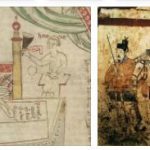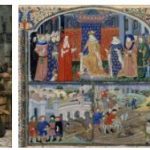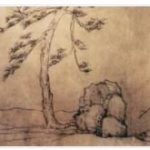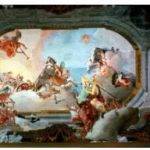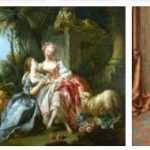Swedish art, term for art that has emerged since the Middle Ages, after the prehistoric and early historical epoch (Germanic art, Northern Europe).
Architecture
Most of the Swedish buildings of the Middle Ages were made of wood. Only sparse remains of this, but noteworthy in terms of art history, have survived (Hemse stave church, 11th century; Stockholm, State Historical Museum). In church construction one gradually went over to quarry stone; The earliest evidence is Saint Per and Saint Olof in Sigtuna (12th century; ruins). The Romanesque cathedral in Lund (crypt from 1123) follows Lombard and Rhenish models and set the style for Sweden. In the middle of the 12th century, Cistercians came to the country; They first founded the Alvastra monastery on Lake Vättersee (ruins), then Varnhem near Skara in 1150 (rebuilt after a fire in 1234; restored in the 17th century) and the Vreta nunnery near Linköping (1162; the current building consecrated in 1289). On the island of Gotland in the 12th In the 13th and 13th centuries there were over 100 village and private churches, the design of which was based on models in Lund and Westphalia – a unique collection of well-preserved medieval monuments in a very small space. This also includes the more monumental churches within the curtain wall of Visby, arguably the best preserved city wall in Northern Europe (around 1270–80).
On the Swedish mainland, the countless small provincial churches dominate (e.g. Husaby near Skara, 12th century, with high westwork and wall paintings). In addition, brick is used as a building material (Gumlösa, municipality of Hässleholm, Scania, consecrated in 1191, according to ethnicityology, Sweden’s oldest brick church); North German brick Gothic was introduced in the cities by the mendicant orders (Riddarholm Church of the Franciscans in Stockholm, 1280 to around 1300), which was also adopted for the episcopal churches (Dome in Strängnäs and Västerås). The Gothic domes of the 13th century (Uppsala, Linköping) do not reach the dimensions of the central European cathedrals; its walls remain more massive, the architectural decorations follow French, German and English models. The well-preserved spacious former monastery church in Vadstena occupies a special position, Birgitta was built from 1369.
Plastic
Medieval stone and wood sculpture is better preserved in Sweden than in most European countries because the Reformation did not cause iconoclasm here. The Gothic stone carving on the island of Gotland, in Skåne and Västergötland (church portals and baptismal fonts) as well as the late medieval reredos and wooden sculptures that were imported in large numbers from Lübeck (“Saint George with the Dragon” by B. Notke) are noteworthy, completed in 1489; Stockholm, Storkyrka Sankt Nikolai); The Gotland ring crosses are a specialty (e.g. Fröjel, 1325–35). Large, figure-rich altar shrines from Brussels and Antwerp were donated shortly before the Reformation (the most magnificent in the cathedrals of Strängnäs and Västerås). Noteworthy Romanesque metalwork are the Antemensale from Broddetorp and the reliquary from Eriksberg (both 2nd half of the 12th century; Stockholm, State Historical Museum).
Painting
In addition to isolated monuments of Romanesque and Gothic painting in the churches of Dädesjö (around 1260) and Södra Råda (in Värmland, 14th and 15th centuries), there are extensive cycles of late medieval wall paintings in large numbers in the churches of Uppland province north of Stockholm (Mälarschule, around 1435-65). The works of the master Albertus Pictor and his circle (Härkeberga near Enköping, around 1480) show an original iconography and drastic realism. Medieval stained glass is mainly found on Gotland (13th century).
Uppsala
Uppsala, capital of the administrative district (Län) Uppsala, central Sweden, on both sides of the river Fyriså, which is navigable up to this point, 149,200 residents, as a large municipality 2,183 km 2 and 214,600 residents; Seat of the Archbishop of the Evangelical Lutheran Church of Sweden; oldest university in Northern Europe (founded in 1477, re-founded in 1593 as a Protestant university) with Sweden’s largest library, coin cabinet and art collection (Gustavianum Museum); Agricultural University (founded in 1977), research institutes (including the Africa Institute), Linnaeus Museum and Garden, Uppland Museum, Museum of Nordic Antiquities, and others; pharmaceutical and food industry; Tourism.
Cityscape
The cityscape is determined by the double-towered cathedral (extensively restored around 1287–1435, 1885–93); the church is a three-aisled basilica with side chapels, transept and ambulatory with chapel wreath (including Finsta chapel with shrine of St. Erik, 1574–80; Wasa chapel with tomb of King Gustav I. Eriksson Wasa [Gustav Wasa], 1583, by Willem Boy); the baroque pulpit (1706-09) was designed by N. Tessin the Younger prepared. Not far from the cathedral is the Holy Trinity Church (beginning of the 14th century). Opposite the cathedral is the Gustavianum (1623), the former main building of the university with the Theatrum anatomicum (anatomical lecture hall); behind it the new university building in neo-renaissance style (1878–87). The castle, begun in 1549 under Gustav Wasa, is located on a hill and was rebuilt after the city fire of 1702 according to plans by C. Hårlemans.
History
With the relocation (1273) of the archbishopric of Altuppsala to the trading center Östra Aros, which was built in the 12th century, this village took over the name Uppsala. It received town charter in 1314 and was the royal seat of the Swedish kings from the middle of the 16th century to the 17th century. The town, which was regularly expanded in 1643, was largely destroyed in a fire in 1702.

